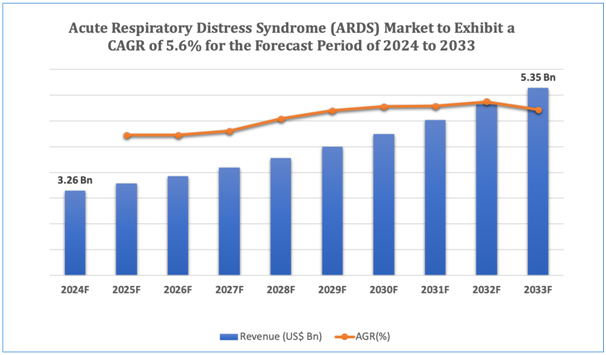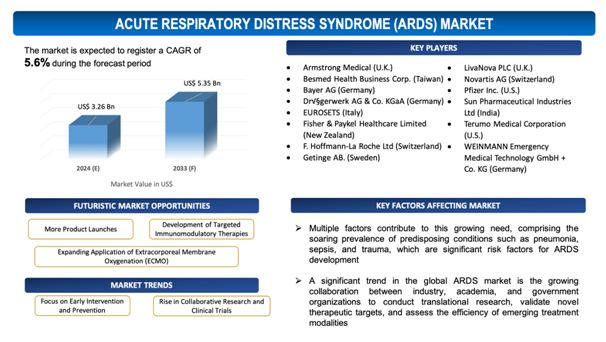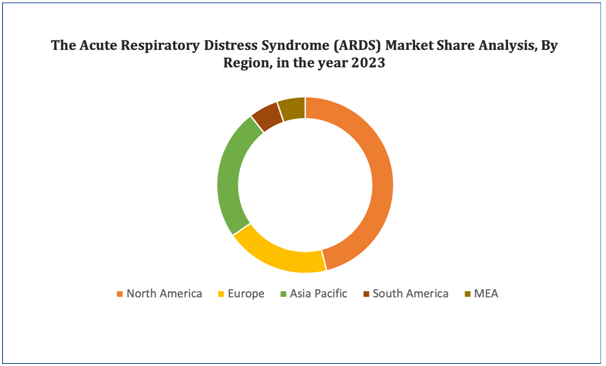Acute Respiratory Distress Syndrome (ARDS) Market Overview
The global acute respiratory distress syndrome (ARDS) market is estimated to be worth over USD 5.35Bn in 2033 and is expected to grow at CAGR of 5.6% during the forecast period (2024-2033).
Acute Respiratory Distress Syndrome (ARDS) stands as a complicated and life-threatening medical condition marked by swiftoutset of severe respiratory failure owing to inflammation and fluid accumulation in the lungs. It basicallyexhibits as complexity in breathing, lesser blood oxygen levels, and swiftly progressing respiratory distress. ARDS is generally triggered by different underlying conditions such as sepsis, pneumonia, aspiration of gastric contents, trauma, or inhalation injuries. The condition can affect individuals of any age but is more common in older adults and those with pre-existing health conditions.
Regardless of these advances in critical care medicine, ARDS continues to presentsubstantial challenges to healthcare providers across the world. It carries an increased mortality rate, scaling from 30% to 50%, depending on the intensity of the condition and the presence of underlying illnesses. Survivors oftentimesundergo long-term complications such as mitigated lung function, cognitive impairment, and psychological distress, focusing on the need for comprehensive management strategies beyond acute care.
The global market for ARDS surrounds a comprehensive spectrum of products and services focused at prevention, diagnosis, and treatment. Pharmaceutical interventions emphasize on minimizing inflammation, improving oxygenation, and modulating immune responses. These comprisebronchodilators, corticosteroids, surfactants, and investigational drugs targeting specific pathways included in lung injury and repair. Medical devices such as extracorporeal membrane oxygenation (ECMO) machines, mechanical ventilators, and persistent monitoring systems hold an integral role in offering respiratory support and ensuring patient safety in intensive care settings.
Along with that, healthcare services such as intensive care unit (ICU) stays, hospitalization, and rehabilitation contribute substantially to the economic strain of ARDS management. The global market for ARDS-associated products and services is influenced by factors such as the prevalence of predisposing conditions, innovations in medical technology, healthcare infrastructure, and reimbursement policies. With a geriatric population, soaring incidence of chronic ailments, and emerging infectious threats, the demand for effective ARDS management solutions is estimated to surge. As a consequence, there is continuing research and development emphasized at enhancing diagnostic accuracy, developing targeted therapies, and optimizing patient outcomes, fueling innovation and investment in the global ARDS market.
Figure 1. Acute Respiratory Distress Syndrome (ARDS): Market Size

Get more details on this report - Request Free Sample
Key Market Insights &Current Market Landscape:
The global acute respiratory distress syndrome (ARDS) market is undergoingrobust growth and innovation fueled by numerous key market insights and developments. One primary trend is the growing prevalence of predisposing conditions such as pneumonia, sepsis, and trauma, accelerating the demand for ARDS management solutions across the globe. In addition to that, breakthoughs in medical technology have paved its way to the development of novel therapeutic approaches and diagnostic tools for ARDS, comprisingpersonalized ventilation strategies, targeted pharmacological interventions, and biomarker-based diagnostic assays. Along with that, there is surging awareness among healthcare providers with respect of the prominence of early detection and timely intervention in enhancing ARDS outcomes, resultingin improved adoption of evidence-based treatment protocols and multidisciplinary care approaches. The market panorama is marked by intense research and development activities emphasized on determining novel therapeutic targets, optimizing drug delivery systems, and exploring innovative strategies for lung protection and regeneration. Collaborations between pharmaceutical firms, academic institutions, and government agencies are fostering the transcription of leading-edge research into clinical practice, fueling innovation and expanding the treatment armamentarium for ARDS. Overall, the global ARDS market stands ready for further growth and transformation, accelerated by continuing advancements in medical science and a soaringfocus on enhancing patient outcomes in critical care settings.
Market Dynamics
Market Drivers
Increasing Demand for Acute Respiratory Distress Syndrome (ARDS) Treatment
Multiple factors contribute to this growing need, comprising the soaring prevalence of predisposing conditions such as pneumonia,sepsis, and trauma, which are significant risk factors for ARDS development. As these conditions become more prevalent owing to factors such as geriatric populations, urbanization, and lifestyle variations, the incidence of ARDS cases is estimated to surge accordingly, fueling the demand for effective treatment alternatives.
Along with that, advancements in healthcare infrastructure and medical technology have enhanced the detection and diagnosis of ARDS, paving its way to earlier identification of cases and induce initiation of treatment. This escalated awareness among healthcare providers regarding the significance of early intervention further accelerates the demand for ARDS therapies.
In addition, with growing public health awareness and healthcare expenditure worldwide, there is a soaring focus on enhancing patient outcomes and mitigating the burden of critical illnesses such as ARDS. This has led to greater investment in research and development efforts aimed at developing innovative treatment modalities and improving existing therapies, further accelerating market growth. Overall, the rising need for ARDS treatment serves as a substantial market driver, encouraging innovation and investment in the global ARDS market to meet the surging demand for effective therapeutic solutions.
Market Restraints
With regard to numerous advantages of acute respiratory distress syndrome (ARDS), the market faces several challenges due to the unique characteristics and requirements associated with them. Some of the key market challenges include:
- Lack of Skilled Professionals: The global ARDS market witnesses a constraint owing to the inadequacy of skilled healthcare professionals with expertise in managing ARDS cases. As the complications of ARDS treatment needs specialized knowledge and training, the scarcity of experienced physicians, nurses, and respiratory therapists can confine the effective delivery of care, specifically in resource-constrained settings.
- Increasing Cost of Treatment Therapeutics: The growing cost of ARDS treatment therapeutics poses a substantial restraint to market growth. Advanced pharmaceuticals, medical devices, and supportive care measures required for managing ARDS can incur significant expenses for patients, healthcare facilities, and payers. This growing cost of treatment can pose financial challenges for healthcare systems, limit access to care for economically disadvantaged populations, and influence reimbursement policies, thusrestricting market expansion.
Market Opportunities
More Product Launches
With continuous advancements in medical science and technology, pharmaceutical firms and medical device manufacturers are continually developing advanced products focused at enhancing the diagnosis, treatment, and management of ARDS. These product launches surrounds a broad range of therapeutic interventions, including novel pharmacological agents targeting inflammation and lung injury pathways, advanced mechanical ventilation systems, and leading-edge diagnostic tools for early detection and monitoring of ARDS.
In addition to that, the emergence of new products often brings forth improvements in efficiency, safety, and patient comfort, tackling unmet needs and improving the standard of care for ARDS patients. Along with that, competition within the market drives innovation and fosters the development of more cost-effective and accessible treatment alternatives, ultimately expanding the therapeutic arsenal available to healthcare providers.
Furthermore, increased product launches can encourage market growth by drawing investment, expanding market reach, and fostering collaborations between industry stakeholders. This inflow of new products not only expands the options available to healthcare providers but also propels research and development efforts, fueling further innovation and advancement in ARDS management. Overall, more product launches present a promising opportunity to improve patient outcomes and accelerate the growth of the global ARDS market.
Market Trends
- Focus on Early Intervention and Prevention: A soaring trend in the global ARDS market is the focus on early intervention and prevention strategies. Determining the significance of timely recognition and treatment initiation in minimizing ARDS progression and enhancing outcomes, healthcare providers are increasingly adopting proactive approaches to recognize high-risk patients, optimize pre-hospital care, and implement preventive measures such as fluid management protocols, lung-protective ventilation strategies, and infection control practices. This trend highlights the prominence of early diagnosis, risk stratification, and multidisciplinary collaboration in lessening the incidence and severity of ARDS and improving patient survival rates.
- Rise in Collaborative Research and Clinical Trials: Collaborative research initiatives and clinical trials hold a crucial role in fueling innovation and advancing ARDS management practices. A significant trend in the global ARDS market is the growing collaboration between industry, academia, and government organizations to conduct translational research, validate novel therapeutic targets, and assess the efficiency of emerging treatment modalities. By pooling resources, expertise, and data across diverse stakeholders, collective research efforts propel the translation of scientific discoveries into clinical practice, support the development of evidence-based guidelines, and foster the discovery of breakthrough therapies for ARDS. This trend indicates the soaringdetermination of the complicated pathophysiology of ARDS and the need for concerted efforts to address this crucial unmet medical need.

Get more details on this report - Request Free Sample
acute respiratory distress syndrome (ARDS) Market: Key Segments
By Cause
- Coronavirus Disease 2019 (COVID-19)
- Sepsis
- Inhalation of Harmful Substances
- Severe Pneumonia
- Others
By Type
- Diagnosis
- Treatment
By Route of Administration
- Oral
- Parenteral
- Intramuscular
- Intravenous
- Others
By End User
- Hospitals
- Specialty Clinics
- Home Healthcare
- Others
By Distribution Channel
- Direct Tender
- Hospital Pharmacy
- Retail Pharmacy
- Online Pharmacy
- Others
By Key Geographical Regions
- North America
- Europe
- Asia-Pacific
- Middle East and Africa
- South America
acute respiratory distress syndrome (ARDS) Market: Regional Analysis
North America dominates the acute respiratory distress syndrome (ARDS) market because of recent technological advancements and the availability of numerous cutting-edge pharmacological molecules to improve the therapeutic process.Asia-Pacific is expected to grow at the highest growth rate in the forecast period as a result of an increase in biotechnology research and centre activity.
Figure 4. Acute Respiratory Distress Syndrome (ARDS) Market: Distribution by Region

Get more details on this report - Request Free Sample
Leading acute respiratory distress syndrome (ARDS) Developers
Industry Trends and Global Forecasts, 2023-2035 report features an extensive study of the current market landscape, market size and future opportunities associated with the acute respiratory distress syndrome (ARDS) market, during the given forecast period. Further, the market report highlights the efforts of several stakeholders engaged in this rapidly emerging segment of the biopharmaceutical industry. Key takeaways of the acute respiratory distress syndrome (ARDS) market are briefly discussed below.
The report includes the list of players operating in the global acute respiratory distress syndrome (ARDS) market. Some of the key players include:
- Armstrong Medical (U.K.)
- Besmed Health Business Corp. (Taiwan)
- Bayer AG (Germany)
- Drägerwerk AG & Co. KGaA (Germany)
- EUROSETS (Italy)
- Fisher & Paykel Healthcare Limited (New Zealand)
- F. Hoffmann-La Roche Ltd (Switzerland)
- Getinge AB. (Sweden)
- LivaNova PLC (U.K.)
- Novartis AG (Switzerland)
- Pfizer Inc. (U.S.)
- Sun Pharmaceutical Industries Ltd (India)
- Terumo Medical Corporation (U.S.)
- WEINMANN Emergency Medical Technology GmbH + Co. KG (Germany)
Recent Developments in the acute respiratory distress syndrome (ARDS) Market
Several recent developments have taken place in the field of acute respiratory distress syndrome (ARDS), some of which have been outlined below. These developments, even if they took place post the release of our market report, substantiate the overall market trends that we’ve outlined in our analysis chronologically.
- In November 2022, Acute Respiratory Distress Syndrome (ARDS) came to the centre stage during COVID-19 pandemic as an end stage factor resulting in high mortality. While many interventions were repurposed to improve oxygen saturation, none were commercially available to specifically address the ARDS globally. Aviptadil is a complex peptide which was not available commercially for ARDS, though used as last resort (orphan drug) and prepared by Universities for emergency use by hospitals.After successful completion of clinical trial, the product has been approved for “For treatment of patients with severe COVID-19 with Acute Respiratory Distress Syndrome (ARDS).”The firm will continue to seek permission for additional use in ARDS in line with permission in EU & USA.
Scope of the Report
The market report presents an in-depth analysis of the various firms / organizations that are engaged in this market, across different segments, as defined in the below table:
|
Key Report Attributes |
Details |
|
Base Year |
2023 |
|
Forecast Period |
2024-2033 |
|
CAGR (2024-2033) |
5.6% |
|
Cause |
|
|
Type |
|
|
Route of Administration |
|
|
End User |
|
|
Distribution Channel |
|
|
Key Geographical Regions |
|
|
Key Companies Profiled |
|
